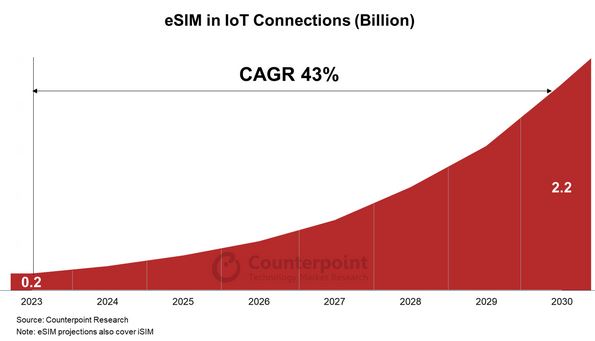Date: 22/02/2024
Counterpoint estimate 43% annual growth in eSIM connections by 2030
The Internet of Things (IoT) landscape is witnessing a significant surge in eSIM adoption, poised to grow at an impressive rate of 43% annually between 2023 and 2030. This projection, outlined in a recent report by Counterpoint Research, underscores the pivotal role of eSIM technology in revolutionizing IoT connectivity.
The introduction of pioneering GSMA standards for IoT eSIM is anticipated to catalyze the adoption of eSIM in IoT ecosystems. These standards promise to expedite the integration of eSIM technology into a myriad of constrained devices, unlocking unprecedented opportunities for seamless connectivity and enhanced functionality.
With IoT connections on eSIM projected to soar to 2.2 billion by 2030, representing nearly a third of all IoT connections, the industry is on the brink of a paradigm shift. This exponential growth trajectory underscores the increasing reliance on eSIM solutions to address the evolving connectivity needs of IoT deployments across diverse sectors.
Despite its status as the largest IoT market in terms of connections, China is trailing behind in eSIM adoption. This disparity raises questions about the underlying factors hindering the widespread adoption of eSIM technology in the region and underscores the need for targeted strategies to bridge the gap and fully leverage the transformative potential of eSIM in China's IoT landscape.
Commenting on the current state of IoT eSIM connections, Associate Director Mohit Agrawal said, “eSIM growth in IoT has lagged behind that in consumer space due to the restrictive M2M eSIM specifications. As a result, at the end of 2023, there were a little less than 200 million eSIM connections in the IoT space despite the excellent product-market fit.”
Agrawal added, “China, the world’s largest IoT market, has low single-digit eSIM penetration due to restrictive regulations around eSIM in the past and the high proportion of LPWA devices which currently do not support eSIM. The eSIM penetration in the rest of the world is much higher than in China but the large IoT base in China brings the overall global eSIM penetration to less than 10%.”
Commenting on the eSIM forecast, Senior Research Analyst Ankit Malhotra said, “The new GSMA standards for IoT eSIM (SGD.31/32) are expected to bring the eSIM to constrained devices, which is likely to massively push the growth in eSIM and later iSIM. eSIM vendors and IoT connectivity providers have multiple proof of concepts on the new IoT eSIM standards and the big push is likely to happen next year after the test specifications are released by GSMA later this year. The early adopters of eSIM in IoT have been mostly automotive customers as the enterprises have not really been able to change the connectivity provider at will”
Source: Counterpoint
Tweet Follow @ecewire

